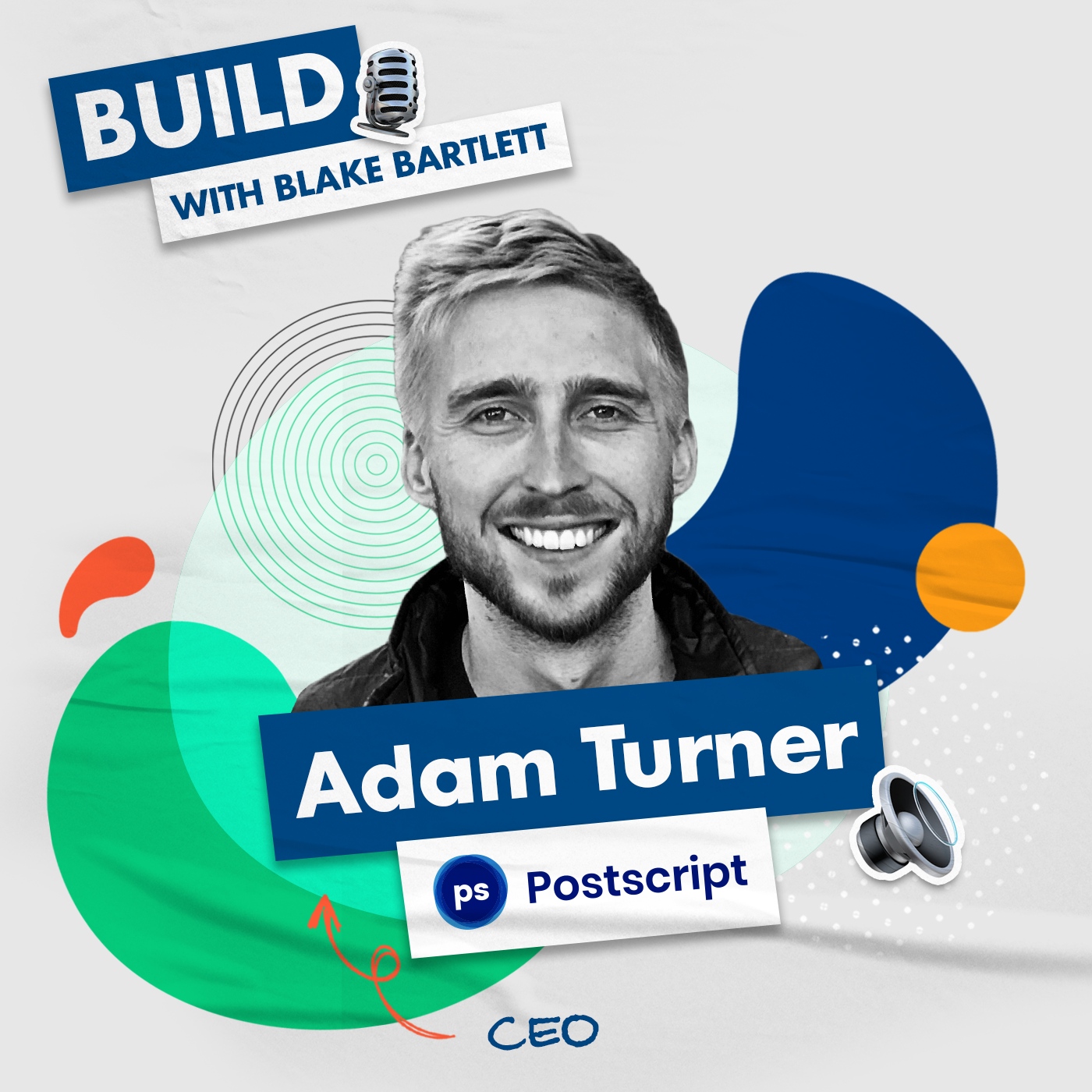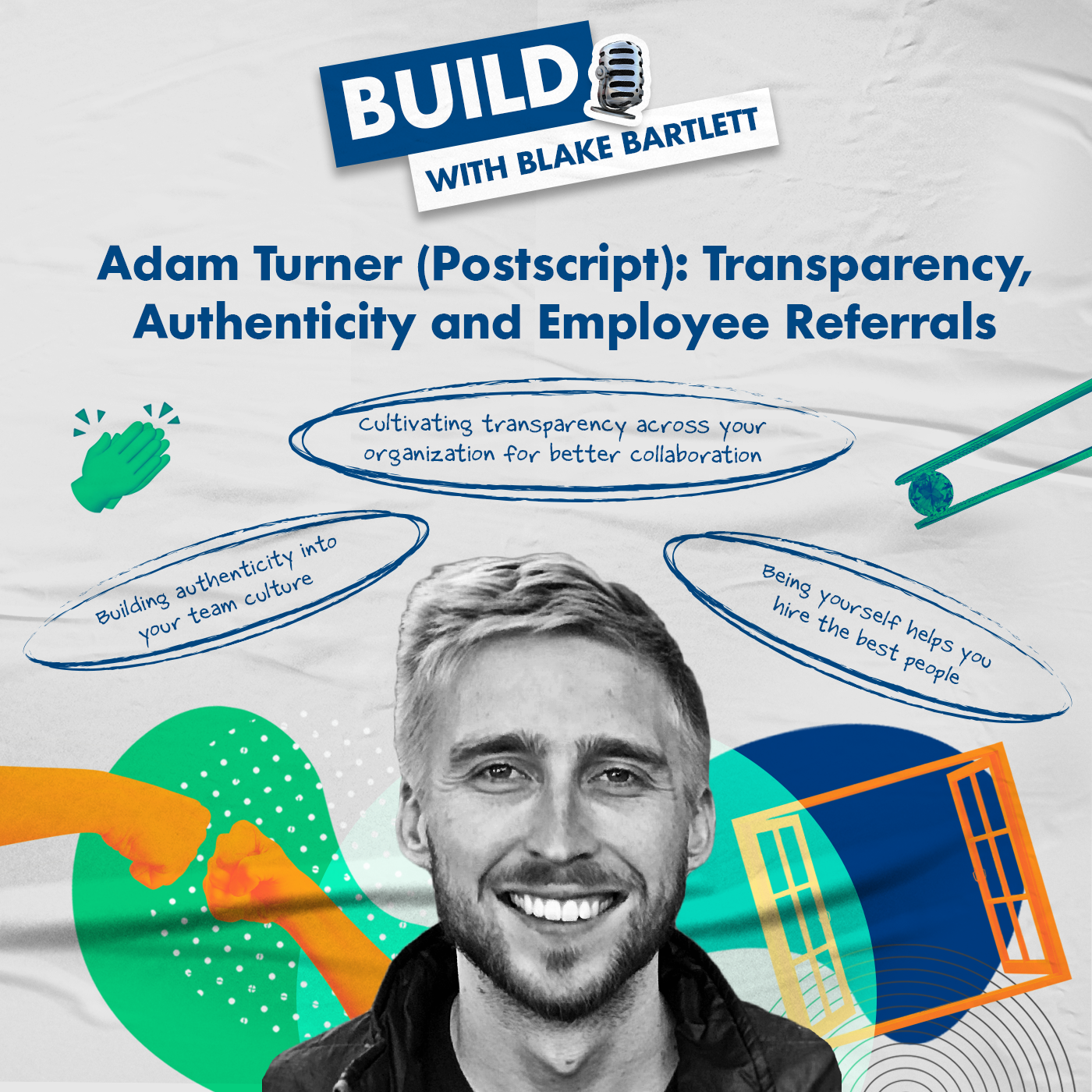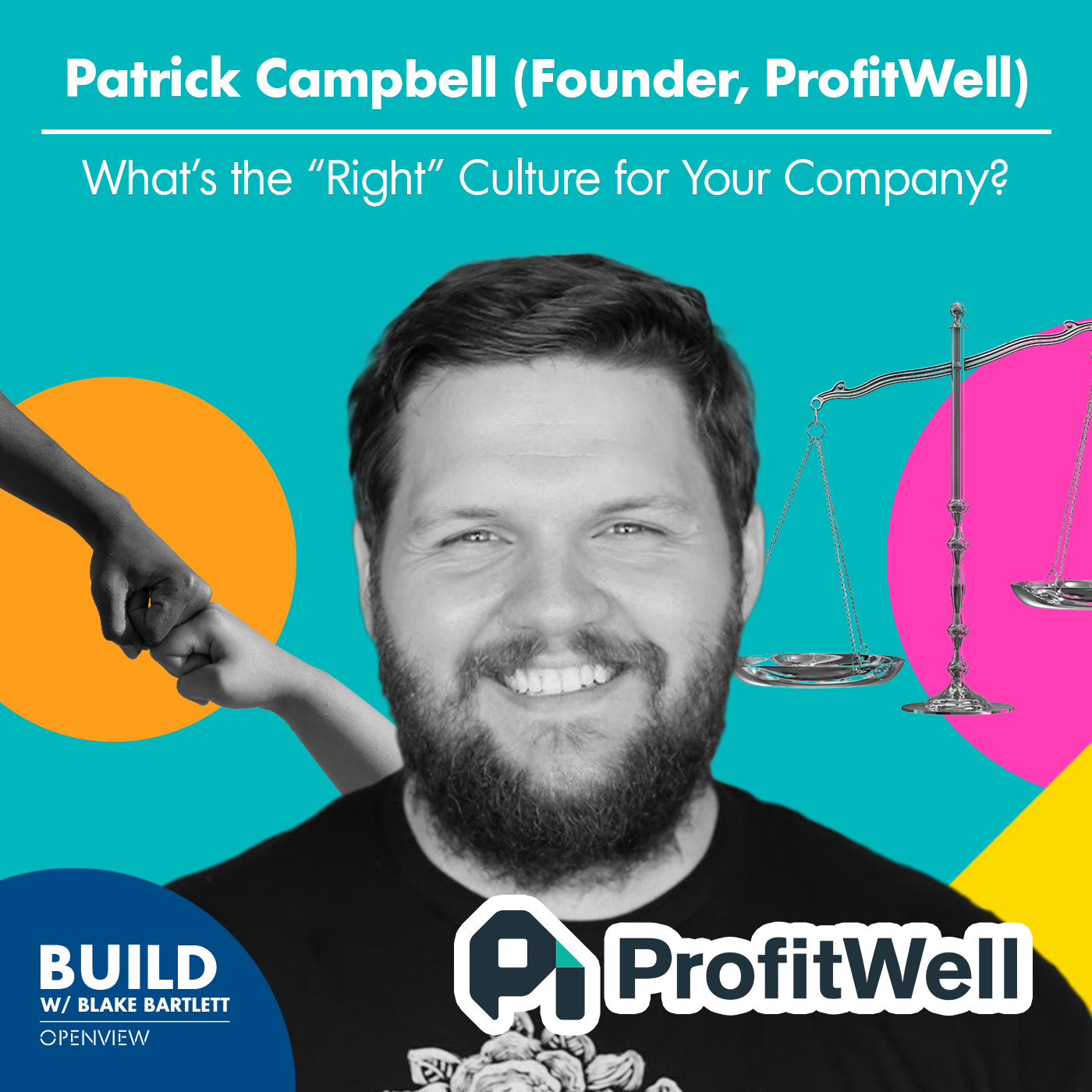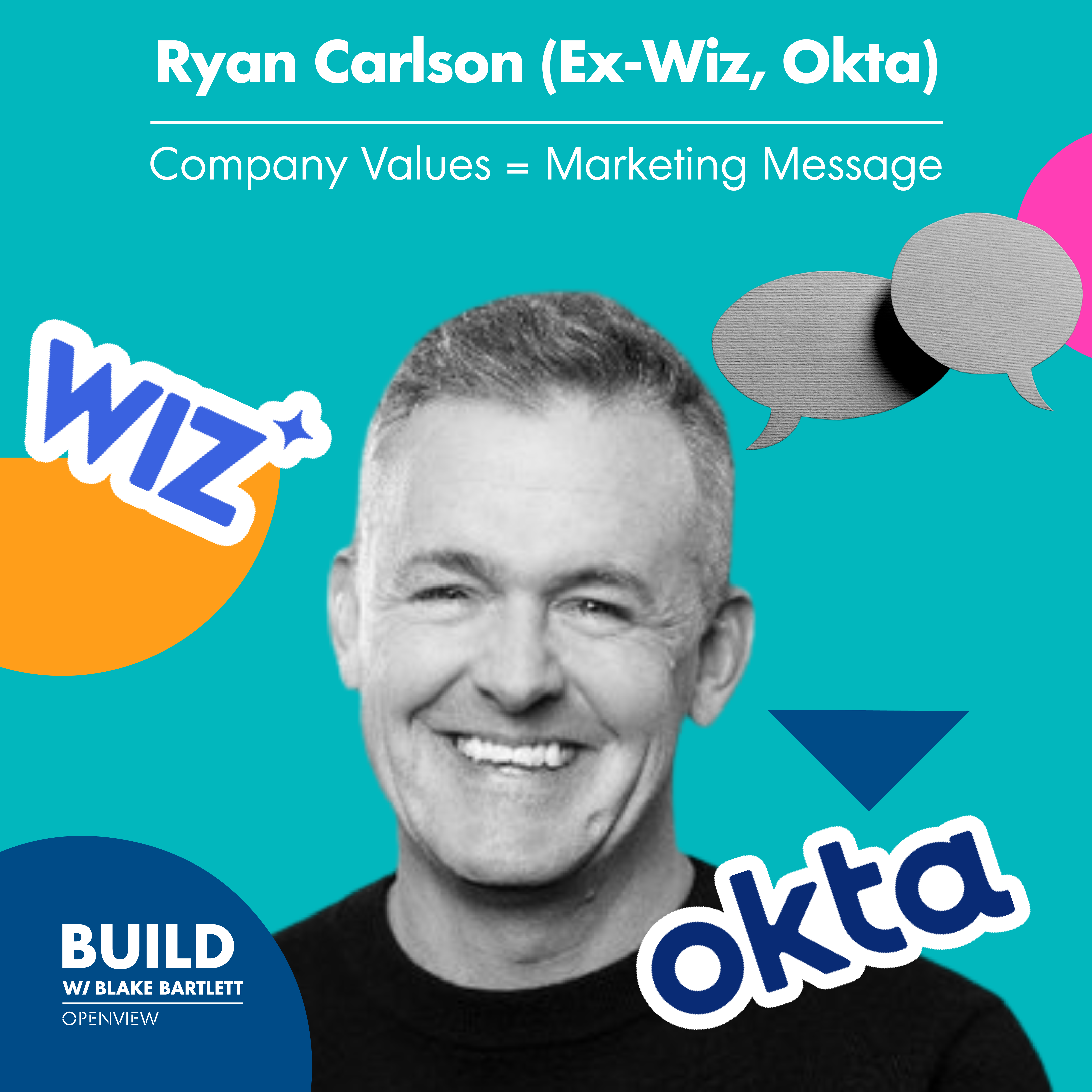Adam Turner (Postscript): Transparency, Authenticity and Employee Referrals
- 0.5
- 1
- 1.25
- 1.5
- 1.75
- 2
Adam Turner: You're going to be given opportunities and you have to understand that it's an opportunity to be authentic and it could be painful in the short term because it's not just, I showed up today and I asked someone how they were doing genuinely. It's we ran into this really challenging thing and we worked through it together or was authentic about my feelings about it. And then we ran into another challenging thing and we did the exact same thing. And so people are definitely measuring the pattern.
Blake Bartlett: Welcome back to the BUILD podcast. I'm Blake Bartlett, a partner at OpenView. The world of SaaS is always evolving and we are here to help you adapt, compete and win with your startup. The BUILD podcast brings you stories and insights from my conversations with the most successful people in SaaS. People in talent are always important topics for startups but today these topics have never been more urgent. This is due to the mega trends we're all experiencing today, like an insanely competitive recruiting environment, Gen Z entering the workplace on mass, along with employee burnout, the great resignation and other retention related topics. Postscript has been navigating these dynamics very skillfully and is seeing strong results across the board. So our goal today is to unpack how Adam and his team have created a culture of transparency and authenticity and how that in turn has benefited their recruiting efforts. All that and more on this episode of BUILD. So let's dive in with Adam Turner. Most conversations about talent and people start with recruiting. How do you attract talent? It's the top of the funnel so let's start there. But today I actually want to start with culture. Postscript has an incredibly strong culture, both in terms of it being high performance and high satisfaction and high belonging. So let's unpack that. How would you describe the culture at Postscript and why do people like working there?
Adam Turner: Sure. So we have our Postscript cultural values but I don't think that that is actually how you would describe the culture. What I believe is that it's like a way for us to have people internally make the right decisions in absence of leadership and these types of things. Those are the cultural values. And so how I would describe it and those are typical startup things like ownership, humility, all the important things. But when I think about, as we gather as an all hands group or as people are engaging in a more social context, I think about transparency and authenticity specifically. And when I say transparency, I don't mean the things that have gotten more steam over the last few years, which is like, we need to be transparent about our career laddering and our comp leveling and metrics about the company. That's like base level. I think that all companies have to have this for people to be excited about them. Do I know the goals of the company? Do I know how we impact there? But I think that it's transparency specifically from leadership and even from board members and from understanding that leadership are real people too and they care about the people that are inside the company. Because it's not just saying," Okay, these are the company level metrics are being transparent about that." It's being transparent about, I understand that everybody who works here has a personal life, they have their own challenges, they have their own needs outside of work life. And we need to understand what those needs are to be able to incorporate a great experience for the person working here. And so I think about it as being transparent about enabling high performers to live their best lives. And to understand that you need to understand the entire, what happens in their entire life, not just what happens at work. And so I think that one of the things that I found specifically that works for me is that my strength can be like vulnerability and so I think that telling a real story about what's happened in my life it in all hands in front of 200 people, helps them understand that, oh, I can actually bring my whole self to work because I see it reflected in the leadership. If I talk about the struggles that I have with hyper growth and adding so many different people and how I've had to grow as a leader, people understand that's the expectation of myself and that's the expectation of others and that I'm not setting of these crazy high expectations for people. I've had to go through it as well. And so I think that that type of authenticity will help people open up and create the culture and those types of interactions get reflected back in recruiting every day because now you have candidates asking questions where, do you have a good sense of the leadership at the company? And they're able to tell the story about, I heard this, these are real people, they care about me and that is how you're going to get those authentic conversations translated into the recruiting process.
Blake Bartlett: I like this idea that transparency, there's the personal angle of transparency, which does bring in being personally vulnerable. And that is certainly a dynamic that I think is incredibly important because it happens so often in startups, the classic dynamic that you're growing so fast that a lot of the people that are now leadership or management, just a few months ago or just a few quarters ago were individual contributors themselves. And maybe this is the first time that they're managers or leaders in their entire career. And so a new hire comes in on that person's team. It could be tempting for the new leader to fake it and make it seem like I know what I'm doing but you're saying that the transparency element is like, no, don't fake it, be vulnerable and if this is your first time managing, leading or facing a challenge, talk about it.
Adam Turner: Yes, absolutely. I think that there's just no more room are facades, you cannot bring a part of yourself that is not what you bring to real life. And I think that part of the difference when we talk back to like gen Z and the younger folks that are entering the workplace, I think that, that's their expectation. And I think that they have the senses to see through it. And when they see something else, when they see someone trying to pretend that they're an expert manager, when they've only had a year or two doing it, I think they see through that. And so if you give them that authenticity directly, then they're saying," okay, I think this is important to me. And I see it in leadership. And I think I can learn from it because I'm learning with them." You're telling me your challenge, you're telling me how you're working through it. That's a learning opportunity.
Blake Bartlett: So why not leaD with the vulnerability, invite them in, say," We're in this together. We're all figuring this out together." That's going to get it to a better result than the inauthentic result, which will just mean they leave. So it's all connected here. Now, another thing is back on some of the numbers and things like that, there still is a role for that. I think, communicating the numbers, the metrics, here's what we talked about at the board meetings or here's what we're talking about as a leadership team, exposing some of those things. But I almost, what I started to hear from you is that it's not so much about the what, like here is the number but the transparency that's needed is the why behind it, why did we make this decision? What's the context on this? What do you need to understand in order to put this number of stat or whatever that we're communicating in context where it's going to mean something for you, any thoughts around that and how you approach that why piece of maybe business strategy or numbers that might be communicated?
Adam Turner: Yeah. And I think that this has become an increasing topic in the last few years where people are saying," Okay, teams perform best when they understand how their day to day reflects back on the company." And people have tried to either make and create new frameworks that match this or have old frameworks match it like," Okay, ours are supposed to do this." Or you have a company level OKR and you have team level OKRs and you have individual OKRs and they all roll up and hypothetically that's supposed to be, okay, this is how you are making an impact on the company. And therefore I want you to understand that. But I think that it is, you have to do this across the board. So it starts with being transparent about the numbers, sharing those numbers and then it goes, next is vulnerability even around those numbers," Hey, we're like not doing so well here." And this is a focus piece for us. And then breaking it down from there. This is the output, these are the different inputs that go into that. And so you have these outputs and then you have the inputs that go into it and you talk about why the inputs are so important. And then you also have the OKRs on top of that. You say," Okay, these are how the different departments are actually affecting the inputs that go into this output." And so being super transparent about the business equation, if you're a SaaS business that's seat based, then you need to understand that an increase of seats is going to lead to an increase in revenue. And so how does each department actually affect the amount of seats? How do the CXMs, the conversations they're having, are they being measured on this metric? Because high performers love goals, whether they're OKRs or not, they love goals and having the goals connect directly to the inputs is another way to roll up those different things.
Blake Bartlett: And you're also inviting in and I think you'll get more creative problem solving out of it. If you just say," I need some more seats, go get me some more seats." Or if, say you're in marketing," I need some more MQLs, go get me some more MQLs." Or whatever it is. I mean, you don't understand the why behind it, then you'll just do what you've always done or you'll do what your boss tells you to do in order to get more of that metric. Back to what I was saying at the beginning is, it could invite creativity like," Oh, that's the problem we're trying to solve. These are the avenues we have tried before. Have we tried this one?" And you might get and you probably will get a bunch of brilliant ideas from the rest of your team, as opposed to just trying to force one option that the leadership team came up with in a brainstorm exception.
Adam Turner: Absolutely. The best ideas are going to be coming from different parts of the company than they were in past decades. And what we're seeing are the frameworks to enable this. One of the things that we do is we have a high level product vision. And the goal of the product vision is not, hey, this is the map of things that we're going to be working on. It's hey, this is the future we believe in. And this is the future that we all agree that we believe in. Now, how are all of you going to build that future? And it's up to you. Let's draw the lines around responsibilities. Let's draw the lines around different scopes. But besides that, you need to invite that ability for are engineers to be thinking about the customer, not just be given tickets that are super broken down that are perfect for a specific type of code. If you have the engineers thinking about the customer experience, as well as the designers, all this type of stuff, then you can break down that decision making responsibility and have that creativity come out through teams or individual contributors or anything like that. Definitely agree there, that you want to enable the creativity as much as possible because that's the reason you brought in all that talent, that's the reason you're investing so heavily in talent.
Blake Bartlett: Now, whether it's transparency personally, whether it's transparency about numbers, whether it's transparency about the context and the why and the strategy behind those numbers, all of those things lead to when you do them in concert and you do them over time and consistently, that is what leads to authenticity. Because I think a lot of times people say," Just be authentic." And it's like," All right, well, how do I do that? Where do I start? Where's the magic authenticity button that I press?" And I think this path of transparency and multifaceted of transparency is what leads to authenticity and an authentic culture, is that how you see it at Postscript?
Adam Turner: Yeah. I think that you're going to be given opportunities and you have to understand that it's an opportunity to be authentic and it could be painful in the short term. Because it's not just, I showed up today and I asked someone how they were doing genuinely, it's we ran into this really challenging thing and we worked through it together or I was authentic about my feelings about it. And then we ran into another challenging thing and we did the exact same thing. And so people are definitely measuring the pattern. And also as you're bringing on new people, they need to see it too. And they need to see it exhibited day to day. They can't just trust the person next to them, that leadership is being authentic or that the culture at the company is authenticity. This is something that you need to prove time and time again. And so that's why it makes it so hard to fake because you're going to have so many different opportunities, which are also challenges to display this. And sometimes it's going to be painful, you're going to get some tricky questions, you're going to have to say," I don't know." In front of people that expect you to know and that those are the times where you need to make sure that you're consistent about it and that it rings true and that it is true.
Blake Bartlett: It seems to me that in your and my past conversations, there's a second side of the coin here. If we're talking about transparency and this multifaceted transparency and that leads to authenticity. The other side of the coin that I know Postscript emphasizes is, I think you describe it as treating your team like adults. What does that mean and how does that connect all of this?
Adam Turner: Yeah. I think that particularly at technology companies, you're going to, whether it's initially or over time, like askew, younger or if you are heavier on individual contributor roles, it's going to be potentially younger. And I think that, especially if you have great leadership, one of the things that you can default to doing and say," Okay, I'm going to have leadership make all the decisions/." or" I'm only going to share this information with leadership." Because it's faster if you need to do that and I could make decisions faster and maybe I am not including these people but this is just the decision that I'm making. But like we were just talking about some of the best creativity can from individual contributors or team members that are newer and also some of the best input into decisions or some of the best questions that you're not considering. Some of the best perspectives can come from people that you might not expect or that previously have been excluded from some of these conversations. And I think that if you treat them like adults, that means that you bringing them the entire picture and you're saying," Hey, these are the things that we're thinking about but we're also open to your discussion here and we want to hear your perspective." I think that it's easy to become very fear based while you are deciding to do that. You say," If I show this to so and so, if I present this information to so and so, are they going to freak out? Are they going to lose faith in the company?" All that type of stuff but really time and time again, I've seen that the more transparent you are with things that are potentially, you have fear about to begin with, it always ends up better than if you hid something from your company or if you treated them like they needed to be sheltered or you need to keep them safe. And so that's something where it's a muscle, you have to flex it all the time. I think that this even translates into how, this might be unrelated but to how parenting over the last couple decades has grown. Where if you actually treat children like adults and you give them the full picture, then they actually respect that a lot more and you can develop a even better relationship with them. And I think that the same is true within the entire company where you treat everybody like adults because you need to be real that entrepreneurs also, there are things that they don't know, nobody is all seeing all knowing. And the more you can spread out decision making across the company and spread out creativity, the better results that you're going to get but it becomes, sometimes it's tougher to get into that flow for sure.
Blake Bartlett: The parenting example is like the old school way was, kid asks," Why?" Parent says," Because I said so." That's our way, like in companies, employee asks," Why?" Management says," Because I said so." And that's obviously just not helpful and not the way the world is moving. So bringing this together, I guess, really it sounds like this treating folks like adults, it seems obvious but there's all these impediments that naturally pop up in our heads that make us think, well, it's going to be bad, I need to shelter people from bad news but that's actually not the thing to do. Don't reposition it, don't posture it, don't hide it, put it out there and people will be surprisingly resilient in dealing with it and will be surprisingly appreciative of the fact that you were back to the beginning point, transparent about these things. And it almost invites that personal agency for people to step up and to be adults by presenting it that way.
Adam Turner: Absolutely. And I think that for some of the most talented people in the workforce right now, I think some of the better opportunities for them outside of working at your company are to start their own company. And I think that while starting your own company, there's a lot of benefits, there's a lot of downsides but part of what that is, is being able to make decisions for yourself and being able to be involved in important decisions and feel like you're making a difference. And so if you're giving that to team members genuinely in the workplace, then I think that, that can also help when it comes to retention because they're learning at a lot faster pace. And they're saying," Okay, not only is this company treating me right when it comes to compensation, when it comes to culture but also I'm involved in these decisions that I don't think I would be at other companies." They're constantly doing these measurements. You're seeing folks get emails, maybe five times a day from recruiters with different opportunities. But I think that if you're hitting these things really well, I think that you are going to be in the top percentage of companies that people want to work at.
Blake Bartlett: Now to make this a little bit more specific. A lot of times, obviously this means that you're delivering bad news or news that you might perceive to be bad or unfavorable or not what you would love to be telling somebody. There's trade offs or something's changing that affects their role, their team, an initiative that's been running. So in that context, how does this role of transparency of treating folks like adults, invitation to personal agency, how does that all come together when you are delivering bad news or challenging news?
Adam Turner: Sure. So, one example that I can think of is with a product delivery team that we had, which consists of a couple engineers, an engineering manager, product manager, all that type of stuff. They were working on a project for three months and we were essentially ready to launch the entire thing to our customer base. But we had a problem with one of our outside vendors that didn't allow us to launch it. And so this is something where you could say a bunch of different things. As leadership, you could just say," We're changing priorities. We're going to have you all work on this different thing." And that could be the final decision. But instead if you bring this to the team, you sit everybody down and you say," Hey, this is the conversation that we're having with our outside vendor. This is what they're saying. This is what we're saying. What do you all think about this?" And this doesn't mean that you have to encourage democratized decision making. We're not taking a vote here. What you're saying is, this is what's happening. I want you to have the entire story and these are the different things that we could do. What do you all think? And even then, just like we talked about the creativity side of things, you could have someone say," Well, what if we did it this way?" And so if you have someone say that, then you would've missed out on entirely on that idea by telling them they're going to be working on a different thing. And so what we ended up doing is we decided to pivot that team and have them work on a different project during the time that we were sorting things out with the vendor. And that became really difficult for some folks because they were saying," I put all this work in, now we're not doing it. This is difficult for me to transition." And I think that by giving them the reality of the situation and talking with them and saying," Hey, this is a startup, things are going to be super dynamic. And also I'm not going to lie to you and say that this is the only time that's going to happen. This is going to happen again. This is going to happen again. We have to be dynamic. And could you take this and turn it into an opportunity for yourself?" And specifically, I remember one person particularly struggling with it. They made it it through and they are one of our best team members yet. And they take that experience and they're able to explain it to other team members that are potentially struggling with more dynamic workplace priorities changing, all these different types of things. And so, yes, it can be difficult to tell these things to people because yes, you risk someone getting so upset that they potentially leave your company or that they potentially can't work with other folks in the company. But what you gain potentially are new ideas that you didn't have before, an understanding of the entire situation and buy into where now that person becomes a culture carrier for you in that sense, they will now take that along to everybody else at the company. And it's the upside is, just incredibly outweighs the downside there.
Blake Bartlett: So if we take all the stuff we've been talking about related to culture and we connect it back to recruiting, I think that the angle here is probably around referrals and referrals, everybody knows that referrals with the best channel. Everybody wants more referrals but there's no magic button that just gets you more referrals. So how do you connect, a lot of the conversations we've been having around culture back to recruiting and specifically referrals?
Adam Turner: Yes. So, like I mentioned before, the referral can be seemingly easy because you're like," Okay, I'm going to just give people cash for example and they're going to bring other people into the company." But really, I think that the largest source of friction to referrals at your company, is the experience that people have at the company today. And exposing that experience to people that they care about in their personal lives, whether it's people that they've worked with, whether it's friends, whether it's anything like that, what they're doing by making that referral is actually putting their reputation on the line. And so they want to see in their time with the company that the company reflects the authenticity, the transparency, the culture that they care about before they bring someone else in. And so I think that you have to get the base level stuff right, like compensation, compensation leveling, getting ahead of those types of things, being transparent about your numbers. But also like we talked about, being authentic, being transparent in decision making, bringing in other people in decision making. And I think that by giving people that experience, then you get that magic referral engine that we've talked about because that is, I believe the biggest point of friction. And what you need to do is get over that hump, not just pour more money into the engine or anything like that. Because in the scope of things, the small referral bonus that people get is nothing compared to them actually putting their reputation on the line and bringing people into a company that they believe will take care of that person as well.
Blake Bartlett: Are there other ways maybe, perhaps indirectly that you see culture directly affecting the recruiting and the referral pipeline?
Adam Turner: So obviously you have your team members that are going to be reaching out to other people that they've worked with, their friends and family to potentially apply to the company. But also as your recruiting team is doing their out bounding or as people are looking at different job boards and potentially where to work, they are also doing their research across every website they can find anything about the company. So you have your classic things like Glassdoor but also what people are doing is they're saying," Okay, how do customers actually think about this company? And do I want to work at a company where customers love it or hate it?" And that can be a huge red flag for people. And so for us specifically, we find that candidates are proactively looking at the Shopify reviews that we have or the G2 reviews that we have in seeing that, oh, team members are being called out for the work they're doing on support. Shera did this for me and it helps me make more money as a business, that reflects a lot of what we talk about as a business where Postscript is here to make merchants more revenue. And we care about the merchant who's working in their garage, roasting coffee for people around the world. And so those types of reviews can do a lot for you when it comes to either the outbound or inbound efforts that you have for the recruiting side of things. So in that sense, I do believe that these indirect referrals where essentially you have customers referring candidates to you, can be incredibly exciting and also just a renewable source of energy for the business.
Blake Bartlett: People are always going to read everything that exists. And so having good customer reviews is obviously good for many reasons. It is that social proof and it does communicate that customers actually like our product and get value out of it. But there's almost this added benefit and what you can't engineer, you certainly can't manufacture teammates getting called out in reviews by name, that has to come back to what we were saying before, has to come from true authenticity. So that's like a magical connection and a social proof that you can't buy.
Adam Turner: Yep.
Blake Bartlett: So we've talked about a lot today and for folks that are listening right now, it can perhaps feel like a lot to do all at once. If folks are in that position, what's a good starting point. Any advice that you have for them.
Adam Turner: Sure. I'd say the most important thing is to start with yourself. If you can't make company level change, unless you are able to understand how the conversations that you have day to day are transparent. Something that even you can work on, for example, as a sales leader and the sales conversations that you're having, being more vulnerable to customers actually helps you develop trust even faster. And so for me, specifically the vulnerabilities helped in conversations. But I also think that if you feel like you are putting up a facade or coming into work with something that isn't truly yourself, then people can probably tell. So if you people see that you're able to open up and this may not be you, just be authentic. For me, it's about opening up and talking about my challenges, for you it might be something different but the more you can understand how employees are going to be both looking at your behavior and saying," Do I want to follow this person?" But also they're going to be mimicking your behavior to the people around and that is going to be what actually creates your culture. In addition to values and frameworks that you set. But these micro things, these actual human to human interactions are going to be by far what determines your culture rather than anything else you set at the company. And so I'd say, invest in those, invest in your day to day interactions with the people, invest in how you communicate. And for me, authenticity is important in saying the truth, despite potentially having fear about the repercussions, getting through that fear is the first step.
Blake Bartlett: Well, Adam, you've done a lot to educate me on this call or on this conversation about really demystifying this idea of transparency and authenticity in company culture. It sounds easy when people describe it in real life but then when you hear about the actual processes to make it a reality, it can seem daunting or seem like lightning in a bottle. And you've outlined a framework or an approach that is very accessible to folks and accessible to me. So thank you for walking us through your wisdom here. This has been great.
Adam Turner: Sure. I appreciate it. And also if I have one thing to add, I'd also say that, if in any situation you are feeling fear or anxiety, that is going to be an opportunity. And so dig deeper into those opportunities as they come up because those are going to be what employees are looking for. And they're going to see how you react in those situations.
Blake Bartlett: It's become a little bit of a tagline these days but at least in the startup worlds but seek discomfort. That's what it means. If you feel the pain, if you feel the, it's going to be tough to be vulnerable here, go to it and embrace it as opposed to running away from it and hiding it.
Adam Turner: Absolutely. There's so much noise today in all of our day to day that sometimes the strongest signal can be discomfort.
Blake Bartlett: Thanks for listening to this episode of BUILD. If you like what you've heard, leave us a review on Apple Podcasts and subscribe to stay up to date with all the new episodes. Want more insights from OpenView, follow me, Blake Bartlett on LinkedIn for daily PLG content and head to our website to sign up for our weekly newsletter.
DESCRIPTION
Key Takeaways:
[2:01] Adam describes the culture at Postscript and explains why people like to work there.
[6:10] Leadership needs to be able to model vulnerability and authenticity, for everyone else to learn to act authentically, too.
[7:11] How can the why behind the goals be approached?
[9:40] The best ideas come from different parts of a company, but the right frameworks to enable this creativity need to be in place.
[11:19] The consistency in transparency is what leads to authentic culture.
[12:54] Adam explains the meaning of “treating your team as adults” in Postscript culture.
[16:39] Treating team members as adults also helps with retention.
[17:30] How does this role of transparency, treating team members like adults, and encouraging personal agency, come together when you are delivering bad news or challenging news?
[20:40] How does Adam connect culture to recruiting, and referrals?
[22:09] Are there indirect ways in which culture directly affects the recruiting and referral pipeline?
[24:25] Adam shares advice for those who are at a starting point.
[26:55] Seek and embrace discomfort.
Mentioned in this episode:
Adam Turner, Co-Founder and CEO of Postscript
Follow Blake Bartlett on Linkedin.
Podcast produced by OpenView.
View our blog for more context/inspiration.
Today's Host

Blake Bartlett
Today's Guests







